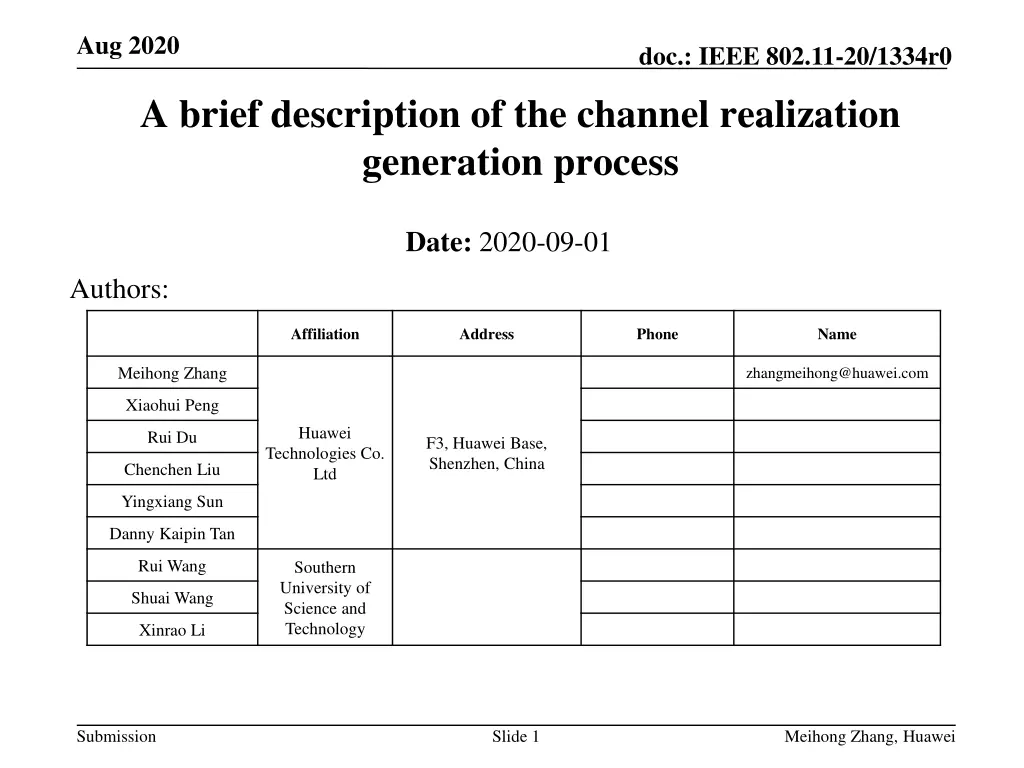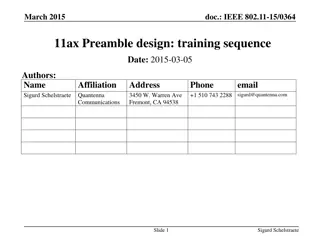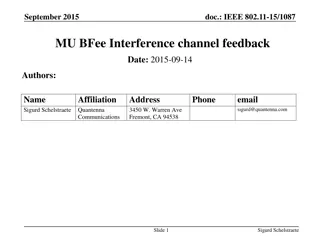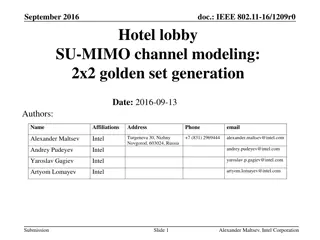
IEEE 802.11-20/1334r0: Channel Realization Generation Process
Explore the detailed process of channel realization generation in the context of WLAN sensing, focusing on aspects like channel modeling, scenario considerations, and approaches for channel parameters generation and analysis. The document discusses the generation process of both target-unrelated and target-related rays, highlighting steps and methods for accurate channel coefficients update.
Download Presentation

Please find below an Image/Link to download the presentation.
The content on the website is provided AS IS for your information and personal use only. It may not be sold, licensed, or shared on other websites without obtaining consent from the author. If you encounter any issues during the download, it is possible that the publisher has removed the file from their server.
You are allowed to download the files provided on this website for personal or commercial use, subject to the condition that they are used lawfully. All files are the property of their respective owners.
The content on the website is provided AS IS for your information and personal use only. It may not be sold, licensed, or shared on other websites without obtaining consent from the author.
E N D
Presentation Transcript
Aug 2020 doc.: IEEE 802.11-20/1334r0 A brief description of the channel realization generation process Date: 2020-09-01 Authors: Affiliation Address Phone Name Meihong Zhang zhangmeihong@huawei.com Xiaohui Peng Huawei Rui Du F3, Huawei Base, Shenzhen, China Technologies Co. Ltd Chenchen Liu Yingxiang Sun Danny Kaipin Tan Rui Wang Southern University of Science and Technology Shuai Wang Xinrao Li Meihong Zhang, Huawei Submission Slide 1
Aug 2020 doc.: IEEE 802.11-20/1334r0 1. Abstract In [1], a discussion of WLAN Sensing channel model was presented, including - The necessity and some initial thinking for WLAN Sensing channel modelling. In this contribution, the following point will be further discussed: - A brief description of the channel realization generation process. Meihong Zhang, Huawei Submission Slide 2
Aug 2020 doc.: IEEE 802.11-20/1334r0 2. Scenario We consider a scenario including, - AP (TX) and STA (RX) are located in the environment, like the living room, conference room; - fixed scatters (walls, chair, table, ) ; - a device free target is moving. d for channel models covering, e.g. Target (initial position at snapshot s) Target (position at snapshot s+1) Fixed scatter (e.g. table) Target trajectory Fixed scatter (e.g. chair) TX location RX location Meihong Zhang, Huawei Submission Slide 3
Aug 2020 doc.: IEEE 802.11-20/1334r0 3. Approach without considering second order reflections (Overall) We first divide the rays into 2 types, - Target unrelated: rays reflected from fixed scatters, LOS ray without human shadowing; - Target related: rays reflected from targets. Overall process of channel realization generation, Input variable - channel input parameters (TX/RX position, snapshot s, ...) Generate target unrelated rays channel parameters as 11ax/ay Generate target related rays channel parameters Postprocessing / analysis Update the channel coefficients Meihong Zhang, Huawei Submission Slide 4
Aug 2020 doc.: IEEE 802.11-20/1334r0 3. Approach without considering second order reflections (Step 1) For target unrelated rays, steps for generating the channel parameters, - For sub 7GHz, approach is same as or based on 11ax [2] , - For 60GHz, approach is same as or based on 11ay [3], Input variable - channel input parameters (TX/RX position, snapshot s, ...) Generate target unrelated rays channel parameters as 11ax/ay Generate target related rays channel parameters Postprocessing / analysis Update the channel coefficients Meihong Zhang, Huawei Submission Slide 5
Aug 2020 doc.: IEEE 802.11-20/1334r0 3. Approach without considering second order reflections (Step 2) For the target related rays, we propose 3 types of generation methods, - Option 1: Execute ray tracing software for each snapshot. For each snapshot (including new positions of TX/RX and new position of target), execute the ray tracing software once. Advantages: Input variable - channel input parameters (TX/RX position, snapshot s) Generate target unrelated rays channel parameters as 11ax/ay Generate target related rays channel parameters execute the software Deal with the scenarios case by case, more accurate result can be achieved. Cover more scenarios (different TX/RX positions, target position, snapshot). Disadvantages: More complex and less practical. Postprocessing / analysis Update the channel coefficients Meihong Zhang, Huawei Submission Slide 6
Aug 2020 doc.: IEEE 802.11-20/1334r0 3. Approach without considering second order reflections (Step 2) For the target related clusters, we propose 3 types of generation methods, - Option 2: Integrate an abstract target model into existing channel model. We first establish an abstract model for target (set human as an example, and assume only one ray can be reflected from each part of target model). Target (initial position at snapshot s) Target (position at snapshot s+1) Fixed scatter (e.g. table) Target trajectory Fixed scatter (e.g. chair) TX/RX positions and snapshot (corresponding position of the target or each part of position) set as the inputs. Advantages: Cover more scenarios (different TX/RX positions, target trajectory); Easily to be used in the simulation. Disadvantages: Less accurate due to the abstract model. TX location RX location Input variable - channel input parameters (TX/RX position, snapshot s) Integrated model Generate target unrelated clusters channel parameters as 11ax/ay Generate target related clusters channel parameters Postprocessing / analysis Update the channel coefficients Meihong Zhang, Huawei Submission Slide 7
Aug 2020 doc.: IEEE 802.11-20/1334r0 3. Approach without considering second order reflections (Step 2) For the target related rays, we propose 3 types of generation methods, - Option 3: Establish a database which records the results for different scenarios (with corresponding snapshot) by ray tracing software. We divide the whole environment into several grids (?), for a given target trajectory, the number of ray tracing results we need to record is ??? ??? ?????? ?? - where ??? , ??? are the number of positions of TX and RX respectively, which equal to ?. ?????? ?? is the number of snapshots. Advantages: More accurate result can be achieved; Easily to be used in the simulation. Disadvantages: Cover limited scenarios; The complexity increases with the number of grids. Input variable - channel input parameters (TX/RX position, snapshot s) Generate target unrelated rays channel parameters as 11ax/ay extract the results from the database Generate target related rays channel parameters Postprocessing / analysis Update the channel coefficients Meihong Zhang, Huawei Submission Slide 8
Aug 2020 doc.: IEEE 802.11-20/1334r0 3. Approach without considering second order reflections (Step 3) Some issues like the conflicts of the rays and the effect of other random objects may need to be considered in postprocessing and analysis before updating the channel coefficients. - Specific solutions are TBD. Input variable - channel input parameters (TX/RX position, snapshot s, ...) Generate target unrelated rays channel parameters as 11ax/ay Generate target related rays channel parameters Postprocessing / analysis Update the channel coefficients Meihong Zhang, Huawei Submission Slide 9
Aug 2020 doc.: IEEE 802.11-20/1334r0 4. Approach of considering second order reflections (Overall) We do not divide the rays into 2 categories as previous, all the rays (LOS ray, reflections from target and fixed scatters) are considered together. Two options we proposed above are adopted for generating all rays. Overall process of channel realization generation, Input variable - channel input parameters (TX/RX position, snapshot s, ...) Generate all the rays Postprocessing / analysis Update the channel coefficients Meihong Zhang, Huawei Submission Slide 10
Aug 2020 doc.: IEEE 802.11-20/1334r0 4. Approach of considering second order reflections (Overall) Brief descriptions of the channel realization generation process are shown as below. Input variable - channel input parameters (TX/RX position, snapshot s, ...) 1. Execute ray tracing software Generate all the rays 2. Extract results from database Postprocessing / analysis Update the channel coefficients Meihong Zhang, Huawei Submission Slide 11
Aug 2020 doc.: IEEE 802.11-20/1334r0 5. Conclusion In this presentation, brief descriptions of the channel realization generation process for two conditions are proposed. Meihong Zhang, Huawei Submission Slide 12
Aug 2020 doc.: IEEE 802.11-20/1334r0 6. References [1] 11-20-0906-00-SENS-discussion-of-channel-model-for-wlan-sensing.pptx [2] 11-14-0882-04-00ax-tgax-channel-model-document.docx [3] 11-15-1150-09-00ay-channel-models-for-ieee-802-11ay.docx Meihong Zhang, Huawei Submission Slide 13
Aug 2020 doc.: IEEE 802.11-20/1334r0 Appendix The reason why second order reflections can not be considered in our first approach (divide the rays into target related and target unrelated), 22500mm Target unrelated rays (background environment) Fixed scatter (e.g. table) 12200mm Fixed scatter (e.g. chair) TX location RX location Target (initial position at snapshot s) Target (position at snapshot s+1) + Fixed scatter (e.g. table) Target trajectory Fixed scatter (e.g. chair) Target (initial position at snapshot s) Target (position at snapshot s+1) TX location RX location Target trajectory Target related rays Final model TX location RX location Meihong Zhang, Huawei Submission Slide 14
Aug 2020 doc.: IEEE 802.11-20/1334r0 Appendix The reason why second order reflections can not be considered in our first approach (divide the rays into target related and target unrelated), ? 22500mm Target (initial position at snapshot s) Target (position at snapshot s+1) Fixed scatter (e.g. table) 12200mm Fixed scatter (e.g. table) Fixed scatter (e.g. chair) Target trajectory Fixed scatter (e.g. chair) TX location RX location TX location RX location Target (initial position at snapshot s) Target (position at snapshot s+1) postprocessing + Fixed scatter (e.g. table) Target trajectory Fixed scatter (e.g. chair) TX location RX location Target (initial position at snapshot s) Target (position at snapshot s+1) Target (initial position at snapshot s) Target (position at snapshot s+1) Fixed scatter (e.g. table) Target trajectory Target trajectory Fixed scatter (e.g. chair) ? TX location RX location TX location RX location Meihong Zhang, Huawei Submission Slide 15





















